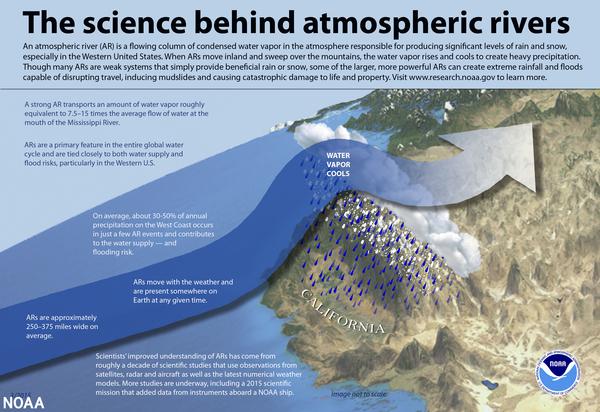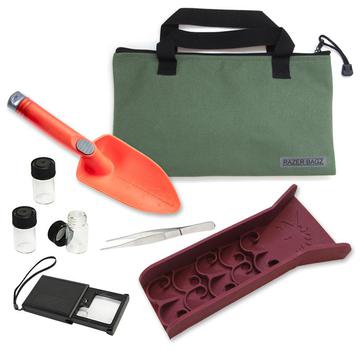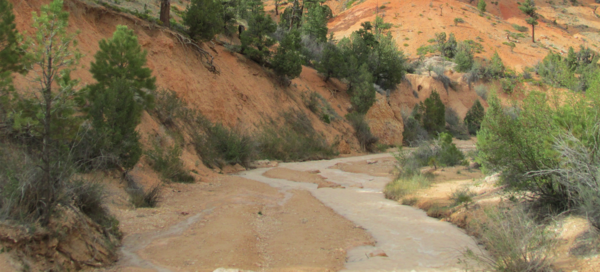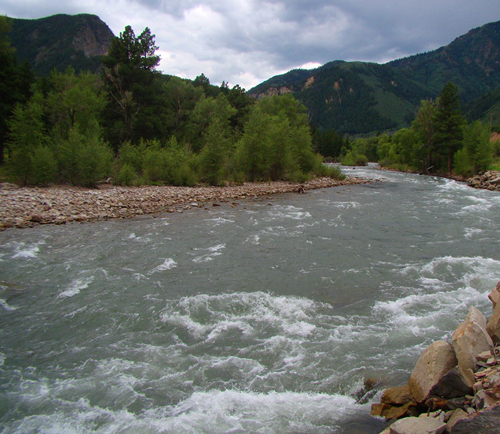Nuggets of News Blog
|  |
Wednesday, March 29 2023
Did you know that “bad” weather can be really GOOD for gold prospectors? Of course no one ever hopes that Mother Nature causes catastrophic loss of life and property, but the ups and downs of weather events in any gold-bearing area are something to take advantage of. Nature can help all of us in our quest for the shiny stuff— especially in light of recent atmospheric rivers causing flooding and lots of snow in California, eastern Idaho, northeast Utah, northwest Colorado, the Cacade Ranges, portions of the northern and central Rockies, and portions of Arizona and Nevada.
 Atmospheric rivers are large, narrow sections of the earth's atmosphere that carry moisture from the earth's tropics near the equator to the poles. On average, the earth has four to five active atmospheric rivers at any time. A vast majority of atmospheric rivers happen in the fall and winter. The northern Pacific Coast receives the bulk of activity in the fall, and the California coast receives more in the winter. Since December 2022, the U.S. West has been slammed with back-to-back-to-back atmospheric rivers. These events provide as much as half of the region’s annual precipitation, bringing much-needed water to parched lands and adding to the snowpack in the high mountains. This year’s storms have done a lot to restore the landscape drought and is “greening up” the landscape and refilling many smaller reservoirs. Atmospheric rivers are large, narrow sections of the earth's atmosphere that carry moisture from the earth's tropics near the equator to the poles. On average, the earth has four to five active atmospheric rivers at any time. A vast majority of atmospheric rivers happen in the fall and winter. The northern Pacific Coast receives the bulk of activity in the fall, and the California coast receives more in the winter. Since December 2022, the U.S. West has been slammed with back-to-back-to-back atmospheric rivers. These events provide as much as half of the region’s annual precipitation, bringing much-needed water to parched lands and adding to the snowpack in the high mountains. This year’s storms have done a lot to restore the landscape drought and is “greening up” the landscape and refilling many smaller reservoirs.
How does this help you get more gold? Primarily, multiple weather events cause large amounts of gold to move and replenish areas that already have been worked. And even when the atmospheric rivers die down, the higher than normal snowpack will cause water levels in rivers to flow well into the summer instead of drying up in late spring. Higher water levels extend your mining season, and allow you to run high-production equipment such as highbankers and power sluices. Miners can also work stream bank deposits once the water recedes back to normal flows.
Typical winter storms that regularly occur in gold-bearing areas usually do not create enough havoc to force substantial amounts of "new" gold into movement. However, when Mother Nature really goes to work as we’ve seen lately, a great deal of gold can be set free, creating a bonanza for gold hunters. Gold veins that have been hidden for decades suddenly can be exposed. Floods can also sweep gold out of abandoned mines and wash it downriver. Known gold digs can be washed out, trees uprooted, and the landscape eroded— all pluses for prospectors! When tons of rock, cobble, and boulders are swept downstream along bedrock during a huge storm, quite a bit of destruction occurs. Plants, weeds, and trees that normally grow along the river and gravel bars are washed away. And when a major storm or flood tears up large portions of a streambed, a fair amount of this newly-released gold, because of its weight, will be deposited along the riverbed and settle into cracks and crevices (hand dredges are an ideal tool in this situation).
Stream bed layers caused by several floods over time are referred to as “flood layers.” Flood layers are usually a different color, consistency and hardness from the other layers of material within the streambed, making them easy to recognize. Larger, heavier pieces of gold will work their way down toward the bottom of a flood layer as they are washed downstream. The smallest and lightest flakes of gold might not work their way down through a flooding layer at all, but might remain dispersed within the material. Of course not all flood layers contain gold in large quantities, but it’s a good place to start. Some of the best areas to look for flood gold are where the stream or river widens out, or levels out, or changes direction. These areas can allow concentrations of gold to collect either on bedrock or in the contact zones between layers. Another place that tends to collect gold are gravel bars, especially the ones located towards the inside of bends in a waterway.
Even if you’re waiting for the weather to settle down and warm up and are not quite ready to start prospecting just yet, get out and keep an eye on the water flow so you can try to figure out where the gold actually drops out. Watch the flow lines around boulders and trees. Watch where the flows slow down. The rule of thumb — gold is in the inside bend where water is slowest — is a rule of thumb, but not always 100% accurate. Look for prospecting opportunities in the flow such as eddies, slack water drop zones and abrupt changes in direction caused by floodwaters. Look above current flows at the high-water mark because debris and bank outcroppings can create diversions in stream flows. Also notice flattened brush or grass and new boulder or cobble deposits. Especially if you’ve had minor gold recovery success in these areas in the past, you could really make out this year and beyond as gold is redistributed.
The 2023 gold mining season promises to be one of the best for small scale miners in many areas— especially California. Don’t miss your chance to experience a banner mining year in the Golden State and other western states. Get out there and get your share of the gold!
Monday, February 21 2022
Depending on where you live and where you like to treasure hunt, you might still be buried under feet of snow. Or maybe spring has sprung and temperatures are on the rise there. No matter the weather, you probably have extra time on your hands this time of year, so put that time to good use. Even though you might not have been out in the field for the last few months, you can still be prospecting and getting prepared for a new season of gold hunting! In other words, use your downtime wisely, so you can hit the ground running as soon as Mother Nature allows.
Inspect equipment. Did you properly clean and store your sluice and/or highbanker at the end of last season? In advance of heading out into the field this year, make sure the pump still works and the matting is in good shape. Run water through all hoses to check for cracks or leaks. Are the riffles bent? What about the header box or hopper? Check bucket handles to see if they’re still sturdy. Do you have adequate sizes of classifiers and gold pans? Inspecting all the parts now and taking inventory will save time in the field later. Ongoing supply chain issues can cause delays, so order early if buying replacement parts or new equipment online. out into the field this year, make sure the pump still works and the matting is in good shape. Run water through all hoses to check for cracks or leaks. Are the riffles bent? What about the header box or hopper? Check bucket handles to see if they’re still sturdy. Do you have adequate sizes of classifiers and gold pans? Inspecting all the parts now and taking inventory will save time in the field later. Ongoing supply chain issues can cause delays, so order early if buying replacement parts or new equipment online.
Prepare your tools. Sharpen digging tools, picks, shovels, chisels and other specialty tools that require sharp edges. Now is also a good time to mark screwdrivers, magnets, crevice tools and other small implements with some bright colored paint. It’s amazing how easily tools can get “lost” in the dirt. A strip of bright yellow or red can help you more easily spot them. Double check the seals on snuffer bottles, hand dredges, and vials to make sure they’re tight. Pack your backpack or tool kit with everything necessary for a full day’s work.
Maintain your metal detector. If your metal detector is still under warranty or giving hints of potential issues, the off-season is ideal for sending it to the manufacturer or taking it to an authorized repair shop to be fixed or tuned up. Check your rechargeable battery and make sure it is fully charged. Better yet, purchase a new battery as a back up. It’s also time to dust off the operator manual or search YouTube for “how to” videos pertaining to your brand and model. You’ll likely uncover some helpful tips and tricks, or learn a new recovery method. Is this the year to add a new coil or pinpointer? Now is a good time to consider upgrades and make those purchases earlier than you expect to use them.
Do your research. The best kind of research brings together different forms of info from a multitude of sources. It is the info gleaned from combined sources that can help you to determine the best possible place to locate precious metal or gems— old mining district reports, mining history books, topo maps, aerial photos. Consult the Bureau of Land Management's LR2000 searchable database. The legacy system is undergoing upgrades; as the new systems is implemented, information will be easier to find. It can take a lot of time to research new areas, but when you find a new spot with good gold, it will be well worth your time and effort! It’s also a good idea to have alternate sites in mind just in case you cannot access your primary sites due to unforeseen closures.
Whether you detect for nuggets, dredge, sluice, or pan for gold, advance preparedness during the winter and early spring will produce better rewards when the 2022 gold hunting season starts. Hit the ground running and avoid equipment malfunctions later by putting your spare time to good use now.
Saturday, November 27 2021
If you’re ready to head to a sunnier climate this winter to do some desert prospecting, understanding the weather a nd topography can add to your success. Before loading up and heading to the Southwest, only to be disappointed by bad weather, first check out the weather patterns for the last 60 days and the predicted weather for the next 30-60 days. Why is that important? Well, it mostly comes down to rainfall— how much and how fast. For example, if there will be a lot of rainfall over an extended time, soils will be loosened and gravity will do its job and cause deeper, and sometimes more concentrated, pay streaks. In general, cool season precipitation (October through April) is the most extensive source of rain in the desert regions. Rainfall is more widespread and of relatively long duration during the cool season. On the other hand, warm season precipitation (May through September) results largely from convective precipitation in the form of short monsoon-type thunderstorms. nd topography can add to your success. Before loading up and heading to the Southwest, only to be disappointed by bad weather, first check out the weather patterns for the last 60 days and the predicted weather for the next 30-60 days. Why is that important? Well, it mostly comes down to rainfall— how much and how fast. For example, if there will be a lot of rainfall over an extended time, soils will be loosened and gravity will do its job and cause deeper, and sometimes more concentrated, pay streaks. In general, cool season precipitation (October through April) is the most extensive source of rain in the desert regions. Rainfall is more widespread and of relatively long duration during the cool season. On the other hand, warm season precipitation (May through September) results largely from convective precipitation in the form of short monsoon-type thunderstorms.
There are three major desert areas that make up the American Southwest:
The roughly 200,000-square-mile Chihuahuan Desert stretches from the southeastern corner of Arizona across southern New Mexico and west Texas to the Edwards Plateau. It runs deep into central Mexico,The Chihuahuan Desert is the most moderate of the three deserts, made up of low and high desert regions and grasslands. It sees the most rain on a regular basis throughout the year with anywhere between 8-12 inches, and areas in New Mexico receive up to 17 inches per year. Unfortunately, because of the Chihuahuan Desert’s higher altitude in southern New Mexico, and the rain patterns there, winter prospecting is a real challenge, especially dry washing. October - March averages 2 inches of rainfall per month, with an average daytime temperature of 55 degrees, making it hard for the ground to dry throughout the season. The pay layer in the Chihuahuan Desert is most likely going to be deeper and more evenly distributed and more highly concentrated than in the Sonoran Desert, but there will be a lot of effort needed to stay on track sampling to find the richest pay layer.
The Sonoran Desert occurs primarily in Mexico. In the USA, most of it can be found in the southern third of Arizona, with small areas in southeastern California.The Sonoran Desert region of Arizona receives between 3-20 inches per year, but these numbers are skewed for the actual low desert gold-bearing region of the state. The Sonoran Desert encompasses a large section of high desert area, ending a few miles south of Prescott, Arizona, following a higher elevation line to the east and west. The normal rainfall in the lower elevation gold-bearing areas of Arizona averages 6 inches annually, all of which falls in about 30 days and includes the monsoons. Yuma is considered the driest area of the state with only 3 inches of rain on average.
The Mojave Desert is primarily in southeastern California and southwestern Nevada, with small portions extending into Arizona and Utah. It has a large amount of high desert elevations and has skewed numbers for the majority of the gold-bearing areas. Lowland areas at less than 1,000 feet elevation average 3.7 inches per year of rain, while Granite Mountain at 4,200 feet above sea level averages 8.5 inches annually. Rich pay layers have been found northwest of Barstow, California by testing and eliminating low to no pay overburden. This area is known for seismic activity with several earthquakes and aftershocks occurring west of the 117 degree meridian, which helps in concentrating gold.
When prospecting in the desert, it’s a good idea to test larger areas in compass headings— testing every few feet north to south to find highest values, then east to west of that spot. Doing so provides you with a line in the desert for further testing. Because of the extended days of rainfall in the Chihuahuan and most of the Mojave compared to the Sonoran Desert, you’ll likely discover a shallow and slightly more compacted layer of good material that is worth processing. However, this “pocket gold” layer can be directly above the really good pay layer you want. Finding gold and digging straight down without continued testing and sampling is not taking advantage of the forces of nature, especially that of water following the path of least resistance and taking the heavies along for the ride. In other words, don’t settle for just any pay layer— follow and use the over burden to get to the BEST pay layer!
If you are planning a desert prospecting trip far in advance, it’s a good idea to start checking weather patterns in April, which is when desert prospecting begins to wind down. That way you will be very prepared when the following fall and winter rolls around. That also gives you time to form a Plan B if the weather is not conducive to your Plan A. If you are a member of Gold Prospectors Association of America (GPAA), there are hundreds of opportunities across the Southwestern states to get on the gold at a GPAA claim. Knowing a little about desert geology is a great start to understanding more about the “why” and “how” gold deposits are formed. And weather is a key factor in knowing “where” gold settles after it breaks from the lode and residuals. Get out there and get your share! Good luck getting the GOLD!
Monday, December 23 2019
Did you know that “bad” weather can be a plus for prospectors? No one ever hopes that Mother Nature causes catastrophic loss of life and property, but the ups and downs of weather events in any gold-bearing area are something to take advantage of. Nature can help all of us in our quest for the shiny stuff!
Typical winter storms usually do not create enough havoc to force substantial amounts of "new" gold into movement. However, when Mother Nature really goes to work over a “bad” winter or for an extended period of time, a great deal of gold can be set free, creating a bonanza for gold hunters in spring and summer. Gold veins that have been hidden for decades suddenly can be exposed. Floods can also sweep gold out of abandoned mines and wash it downriver. Known gold digs can be washed out, trees uprooted, and the landscape eroded. Benched gold deposits can be released and transported back into running streams.
If you’re in an area that experiences high-water events, get out and keep an eye on the water flow so you can try to figure out where the gold actually drops out. Watch the flow lines around boulders and trees. Watch where the flows slow down. The rule of thumb — gold is in the inside bend where water is slowest — is a rule of thumb, but not always 100% accurate.
On the flip side, if drought conditions prevailed last fall and continue this winter, adequate water levels needed for panning and sluicing may be difficult to find. By knowing this ahead of time, you won’t waste your time. You can plan to travel to better areas in the coming months.
Water isn’t the only force that can work in a treasure hunter’s favor. If you are a detectorist, keep an eye on the wind. Downslope winds can strip and scrub away a great deal of surface material. This wind-driven movement of top sands can make an exciting difference— areas that came up empty just last year may suddenly be productive for a metal detector!
Whether you’re in the midwest, southeast, or way out west, water table elevations and annual precipitation can have a significant impact on the amount of gold exposed in waterways, which can affect the probability of what you’ll find in your pan. Greater than average winter precipitation may swell waterways, liberating trace gold previously stranded in ground by droughts of late summer and early autumn. Good luck and be safe!
|






 Atmospheric rivers are large, narrow sections of the earth's atmosphere that carry moisture from the earth's tropics near the equator to the poles. On average, the earth has four to five active atmospheric rivers at any time. A vast majority of atmospheric rivers happen in the fall and winter. The northern Pacific Coast receives the bulk of activity in the fall, and the California coast receives more in the winter. Since December 2022, the U.S. West has been slammed with back-to-back-to-back atmospheric rivers. These events provide as much as half of the region’s annual precipitation, bringing much-needed water to parched lands and adding to the snowpack in the high mountains. This year’s storms have done a lot to restore the landscape drought and is “greening up” the landscape and refilling many smaller reservoirs.
Atmospheric rivers are large, narrow sections of the earth's atmosphere that carry moisture from the earth's tropics near the equator to the poles. On average, the earth has four to five active atmospheric rivers at any time. A vast majority of atmospheric rivers happen in the fall and winter. The northern Pacific Coast receives the bulk of activity in the fall, and the California coast receives more in the winter. Since December 2022, the U.S. West has been slammed with back-to-back-to-back atmospheric rivers. These events provide as much as half of the region’s annual precipitation, bringing much-needed water to parched lands and adding to the snowpack in the high mountains. This year’s storms have done a lot to restore the landscape drought and is “greening up” the landscape and refilling many smaller reservoirs.
 nd topography can add to your success. Before loading up and heading to the Southwest, only to be disappointed by bad weather, first check out the weather patterns for the last 60 days and the predicted weather for the next 30-60 days. Why is that important? Well, it mostly comes down to rainfall— how much and how fast. For example, if there will be a lot of rainfall over an extended time, soils will be loosened and gravity will do its job and cause deeper, and sometimes more concentrated, pay streaks. In general, cool season precipitation (October through April) is the most extensive source of rain in the desert regions. Rainfall is more widespread and of relatively long duration during the cool season. On the other hand, warm season precipitation (May through September) results largely from convective precipitation in the form of short monsoon-type thunderstorms.
nd topography can add to your success. Before loading up and heading to the Southwest, only to be disappointed by bad weather, first check out the weather patterns for the last 60 days and the predicted weather for the next 30-60 days. Why is that important? Well, it mostly comes down to rainfall— how much and how fast. For example, if there will be a lot of rainfall over an extended time, soils will be loosened and gravity will do its job and cause deeper, and sometimes more concentrated, pay streaks. In general, cool season precipitation (October through April) is the most extensive source of rain in the desert regions. Rainfall is more widespread and of relatively long duration during the cool season. On the other hand, warm season precipitation (May through September) results largely from convective precipitation in the form of short monsoon-type thunderstorms. 